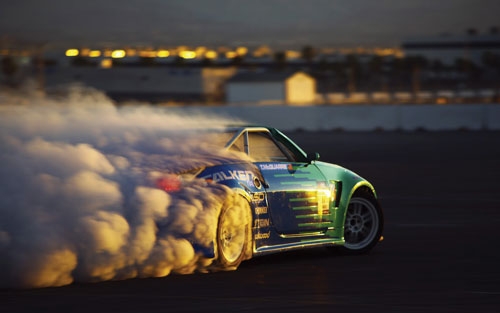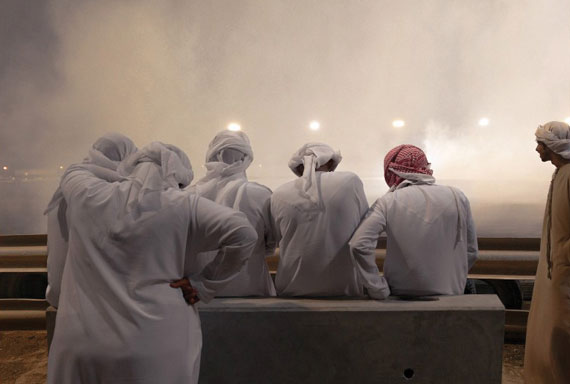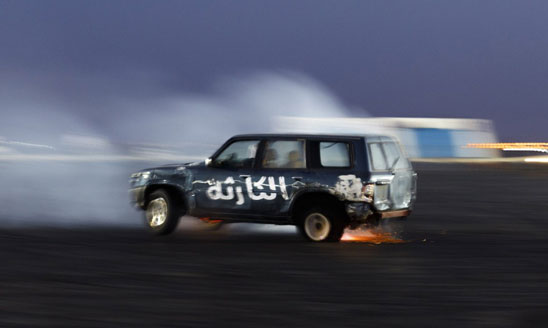Hajwalah hobby is injurious to health!
An SUV races down an open, desert road. Suddenly, the driver whips the steering wheel as hard and fast as he can in one direction, then back the other way. The vehicle spins uncontrollably, skidding across the road.
This dangerous drifting phenomenon is called “hajwalah,” or “tafheet,” and in parts of the Arab world it’s how some thrill-seeking teenagers get their fill.
Young men in Saudi Arabia have been drifting cars since the 1970s, and the practice has since spread to countries such as the United Arab Emirates. It was once popular on public roads, but Gulf state governments have since cracked down on hajwalah due to the high number of traffic accidents and injuries caused by drifters.
Not to be controlled, today’s youth have taken to private tracks and unlicensed garages in rural areas where they are free to be as reckless as they please.
New York-based photographer Peter Garritano traveled to the UAE to capture a part of this subculture for his latest photo series. The photos follow a drifting competition, highlighting different aspects of hajwalah.
One photo shows SUVs lined up for the drifting meet. Mechanics are hard at work under the hoods of these SUVs, which must be modified from their factory configurations to be able to perform signature stunts.
Another photo shows the asphalt covered in aggressive patterns of skid marks, leaving little question about what transpired on those roads.
“It’s kind of like a demolition derby,” Garritano explained. “They get really excited when something explodes or
burns.”
Moving Hajwalah from public roads to private tracks has given rise to a more formalised, competitive drifting culture, cementing it as a legitimate form of motorsport. In drift meets like the one in Garritano’s photos, drivers are judged by panels on their technique and on the audacity of their stunts. But there are no hard and fast rules. Hajwalah is a freestyle sport, and those who display the most fearlessness ultimately prevail.
“It’s like watching a carefully choreographed car accident that hopefully doesn’t end in a wreck,” Garritano said.
The huge risks involved in the stunts, and the vast sums of money spent tricking out vehicles that could easily get totalled after one bold move, make hajwalah a seemingly impractical hobby.
It’s “the same as any teenage man seeking an activity with as much machismo possible,” Garritano said. “But they have money to spend and only so many ways to spend it.”
Perhaps one of the drifters put it best.
“People think we’re hooligans, but there are hooligans everywhere,” the drifter told Garritano. “We just happen to be hooligans with money.” (CNN)
What is Hajwalah?
Strictly speaking it’s nothing more than illegal street-racing. Wikipedia says the phenomenon started in the late 1970s and all required is pure speed.
Which means driving the car at 100 to 160mph and then throwing the vehicle left and right on wide sectioned highways.
The technique, however, does not requires cornering or high-speed racing skills. All you need to do is drive fast and drift sides then recover with opposite lock and don’t even think about safety.
Popular (illegal) manoeuvres
Hajwalah has evolved over time and has now got several variations.
Tanteel is one such manoeuvre. It begins as usual, but adds 4 or more power slides. This technique usually concludes with other methods known as Ta’geed, Sefty, or Axeyat. It is also considered the main manoeuvre.
- Ta’geed: Spinning the car a full 360 degrees while driving either straight or sideways more than once
- Sefty: Spinning the car a full 360 degrees starting from any side and then spinning the opposite side of the first 360 with a short power slide
- Tatweef: Passing another vehicle, truck, or more going sideways at very high speed up to 160 km/h (100 mph) on public highway no matter how busy the traffic is
- Axeyat: Turning the car 180 degrees from side to another completing a full 360 by starting from the right to the left or opposite, kind of street sweeping (Wikipedia)
Related Posts



